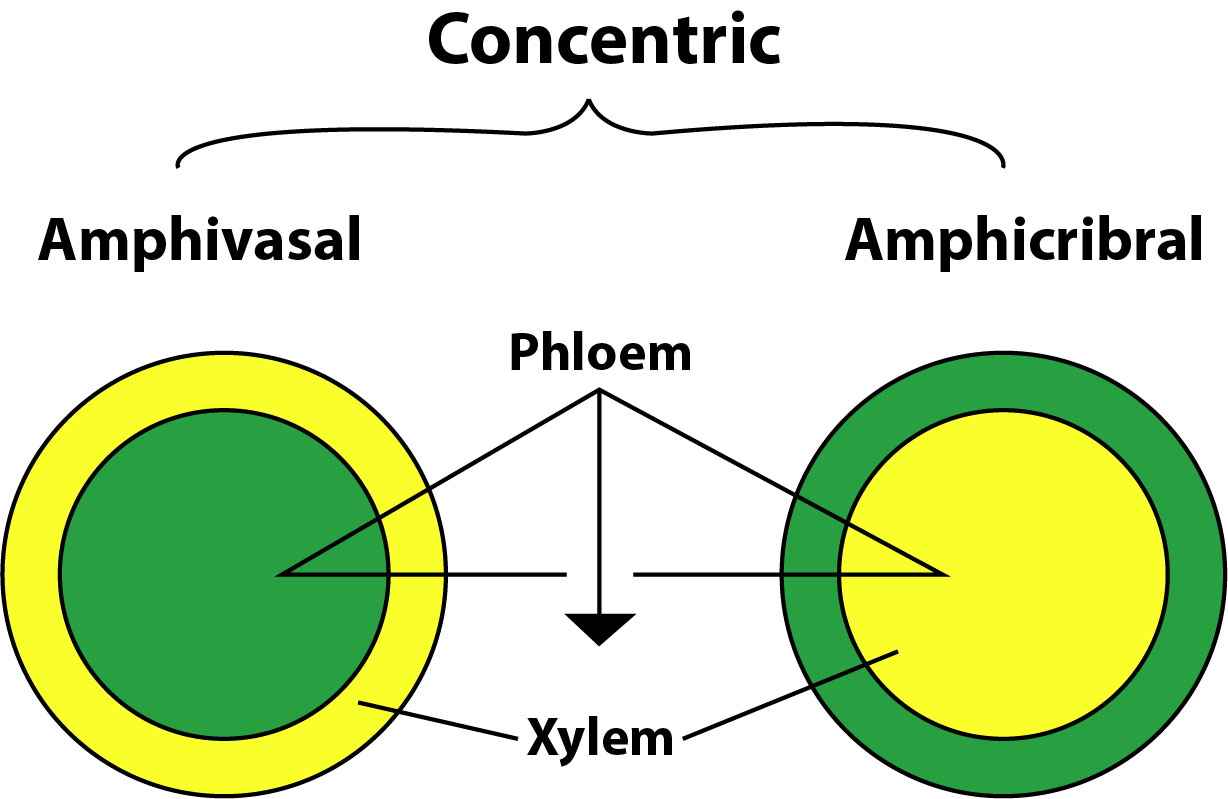
Amphivasal vascular bundles are found in
(a)Cycas and Dryopteris
(b)Dracaena and Yucca
(c)Helianthus and Cucurbita
(d)Maize and wheat
Answer
431k+ views
Hint: Some monocot plants are exceptional and possess a cambial ring in the vascular bundle. In these plants, the vascular tissue is arranged such that the xylem concentrically surrounds the phloem.
Complete step-by-step answer:
Dracaena and Yucca are exceptional monocot plants, which means, despite being a monocot plant they still possess a cambial ring. While in the general case, monocots lack cambium. They are also an exception in the case of an amphivasal type of vascular bundle, possessing a cambial ring.
Figure: A comparison between amphivasal and amphicribral vascular bundles.

Additional Information:
-In the collateral vascular bundle, the phloem is present towards the periphery, external to the xylem.
-An example of a closed collateral vascular bundle is the Asparagus stem.
-In closed type vascular bundle, cambium is absent.
-In the open type vascular bundle, cambium is present.
-Closed type vascular bundles lack secondary growth due to lack of the cambium.
-The cambium of an open type vascular bundle is called a fascicular cambium.
-The collateral vascular bundle is characteristic of the stem of dicotyledons and gymnosperms.
-In the bicollateral vascular bundle, the phloem is located both internally and externally to the xylem.
-Bicollateral vascular bundles are found in stems of some ferns and some members of the Cucurbitaceae family.
-Bicollateral vascular bundles are an open type of vascular bundle.
-Bicollateral vascular bundles are found in Cucurbita stem.
-In the concentric vascular bundle, one type of vascular tissue surrounds the other type of vascular tissue.
So, the correct answer is, ‘Dracaena and Yucca.’
Note: In general amphivasal and amphicribral vascular bundle are closed type of vascular bundles as both lack cambium. Amphivasal vascular bundle is also known as leptocentric (xylem circles the phloem) vascular bundle. In the amphicribral vascular bundle, the phloem surrounds the xylem.
Complete step-by-step answer:
Dracaena and Yucca are exceptional monocot plants, which means, despite being a monocot plant they still possess a cambial ring. While in the general case, monocots lack cambium. They are also an exception in the case of an amphivasal type of vascular bundle, possessing a cambial ring.
Figure: A comparison between amphivasal and amphicribral vascular bundles.

Additional Information:
-In the collateral vascular bundle, the phloem is present towards the periphery, external to the xylem.
-An example of a closed collateral vascular bundle is the Asparagus stem.
-In closed type vascular bundle, cambium is absent.
-In the open type vascular bundle, cambium is present.
-Closed type vascular bundles lack secondary growth due to lack of the cambium.
-The cambium of an open type vascular bundle is called a fascicular cambium.
-The collateral vascular bundle is characteristic of the stem of dicotyledons and gymnosperms.
-In the bicollateral vascular bundle, the phloem is located both internally and externally to the xylem.
-Bicollateral vascular bundles are found in stems of some ferns and some members of the Cucurbitaceae family.
-Bicollateral vascular bundles are an open type of vascular bundle.
-Bicollateral vascular bundles are found in Cucurbita stem.
-In the concentric vascular bundle, one type of vascular tissue surrounds the other type of vascular tissue.
So, the correct answer is, ‘Dracaena and Yucca.’
Note: In general amphivasal and amphicribral vascular bundle are closed type of vascular bundles as both lack cambium. Amphivasal vascular bundle is also known as leptocentric (xylem circles the phloem) vascular bundle. In the amphicribral vascular bundle, the phloem surrounds the xylem.
Recently Updated Pages
Master Class 9 General Knowledge: Engaging Questions & Answers for Success

Master Class 9 English: Engaging Questions & Answers for Success

Master Class 9 Science: Engaging Questions & Answers for Success

Master Class 9 Social Science: Engaging Questions & Answers for Success

Master Class 9 Maths: Engaging Questions & Answers for Success

Class 9 Question and Answer - Your Ultimate Solutions Guide

Trending doubts
State and prove Bernoullis theorem class 11 physics CBSE

Who built the Grand Trunk Road AChandragupta Maurya class 11 social science CBSE

1 ton equals to A 100 kg B 1000 kg C 10 kg D 10000 class 11 physics CBSE

State the laws of reflection of light

One Metric ton is equal to kg A 10000 B 1000 C 100 class 11 physics CBSE

Difference Between Prokaryotic Cells and Eukaryotic Cells




